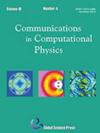用于凯勒-西格尔-纳维尔-斯托克斯模型的保正有限体积与有限元方法
IF 3.1
3区 物理与天体物理
Q1 PHYSICS, MATHEMATICAL
引用次数: 0
摘要
我们提出了一种针对趋化-流体系统的线性解耦正向保留方案,该方案模拟了好氧细菌与其周围流体之间的相互作用。该方案包括在规则三角网上对流体方程采用有限元法(FEM),以及在两种双网格上对趋化系统采用上风有限体积法(FVM)。离散细胞密度和化学浓度在双重网格上表示为片断常数函数。它们也可以等价地表示为质量结块意义上的三角形上的分片线性函数。这些离散解是通过上风有限体积近似得到的,满足正定守恒定律和质量守恒定律。有限元法用于计算三角网中的数值速度,然后用它来确定对偶网格中的上风式数值通量。我们分析了离散系统中矩阵的 $M$ 特性,并证明了其好求性和正保性特性。利用离散拉普拉斯运算器的 $L^p$估计、半群分析和归纳法,我们能够在 $(l^∞(W^{1,p}), l^∞(L^p),l^∞(W^{1,p}))$ 规范下建立化学浓度、细胞密度和速度场的最优误差估计。本文列举了几个数值例子来验证理论结果。本文章由计算机程序翻译,如有差异,请以英文原文为准。
The Positivity-Preserving Finite Volume Coupled with Finite Element Method for the Keller-Segel-Navier-Stokes Model
We propose a linear decoupled positivity-preserving scheme for the
chemotaxis-fluid system, which models the interaction between aerobic bacteria and
the fluid flow surrounding them. This scheme comprises the finite element method
(FEM) for the fluid equations on a regular triangulation and an upwind finite volume
method (FVM) for the chemotaxis system on two types of dual mesh. The discrete
cellular density and chemical concentration are represented as the piecewise constant
functions on the dual mesh. They can also be equivalently expressed as the piecewise linear functions on the triangulation in the sense of mass-lumping. These discrete solutions are obtained by the upwind finite volume approximation satisfying
the laws of positivity preservation and mass conservation. The finite element method
is used to compute the numerical velocity in the triangulation, which is then used
to determine the upwind-style numerical flux in the dual mesh. We analyze the $M$-property of the matrices from the discrete system and prove the well-posedness and
the positivity-preserving property. By using the $L^p$-estimate of the discrete Laplace
operators, semigroup analysis, and induction method, we are able to establish the optimal error estimates for chemical concentration, cellular density, and velocity field in $(l^∞(W^{1,p}), l^∞(L^p),l^∞(W^{1,p}))$-norm. Several numerical examples are presented to verify the theoretical results.
求助全文
通过发布文献求助,成功后即可免费获取论文全文。
去求助
来源期刊

Communications in Computational Physics
物理-物理:数学物理
CiteScore
4.70
自引率
5.40%
发文量
84
审稿时长
9 months
期刊介绍:
Communications in Computational Physics (CiCP) publishes original research and survey papers of high scientific value in computational modeling of physical problems. Results in multi-physics and multi-scale innovative computational methods and modeling in all physical sciences will be featured.
 求助内容:
求助内容: 应助结果提醒方式:
应助结果提醒方式:


